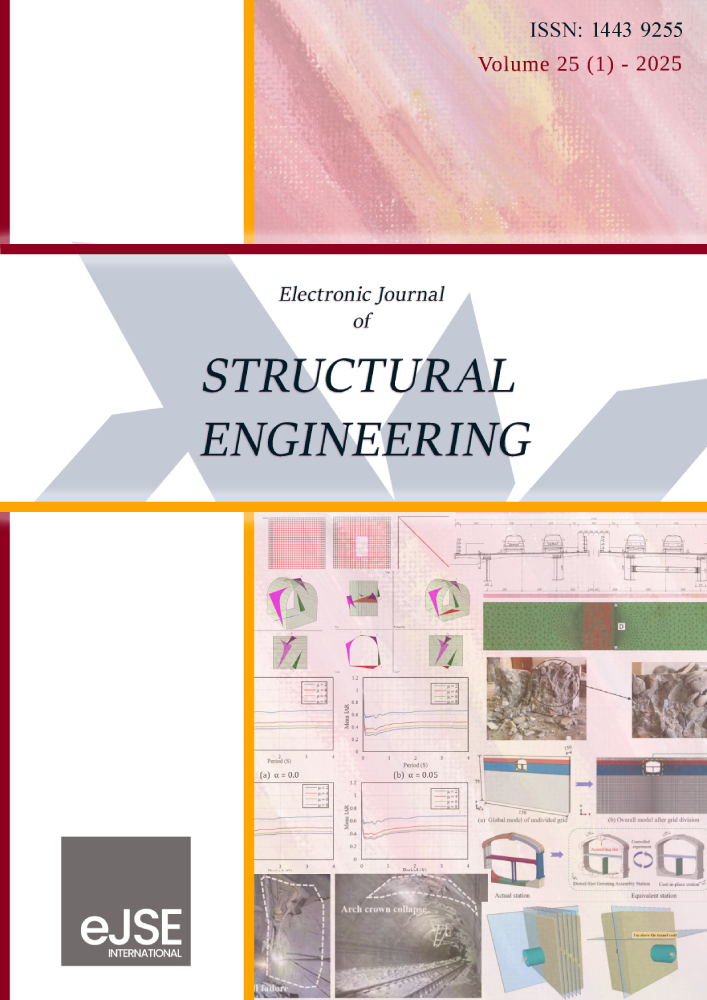Stability analysis of surrounding rocks of deeply-buried underground chambers based on the improved block theory and simulation using unwedge computer program
DOI:
https://doi.org/10.56748/ejse.24714Keywords:
Improved block theory, Unwedge program, Computer simulation, Underground chambers, Surrounding rock stabilityAbstract
To tackle the challenges of extensive drawing workloads and limited precision inherent in the application of block theory, this paper presents an optimization of block theory based on an improved vector method. Additionally, the Unwedge computer program is employed to conduct visual simulations of block theory applications, thereby enhancing the ease of utilizing block theory. To validate the accuracy of our research findings, we conducted a case study on the stability of surrounding rock in the deeply buried underground caverns with complex geological structures at the Jinping-II Hydropower Station. The research results reveal that the refined vector method can swiftly identify the stability of surrounding rock in various study areas, offering a valuable reference for the practical excavation of underground caverns. In the engineering case, safety concerns arise in key block zones with safety factors below 1.5, necessitating the implementation of appropriate safety measures during excavation. Furthermore, some key blocks exhibit a safety factor of zero and are positioned at the top of the cavern. In theory, these key blocks could have a certain impact on the stability of the surrounding rock of the cavern. However, given their minute volume and weight, they can be deemed stable. By comparing the refined block theory and computer program calculation results with the actual construction and excavation process of the underground cavern, we found that they are largely consistent. This underscores that the improved method proposed in this paper can provide theoretical support and a feasible basis for the excavation of deeply buried underground caverns.
Downloads
References
Abdallah, A. M., Zaki, N. G., El Kerdawy, A. M., Mahmoud, W. H., & Mohamed, G. G. (2023). Coordination behavior of cocaine toward d-block metal ions: synthesis, spectral analysis, density functional theory (DFT) studies, and chemotherapeutic activity. Journal of Molecular Structure, 1293, 136301.
Fu, X., Du, W., Sheng, Q., Chen, J., Fang, Q., & Zhou, Y. (2021). Extensions of the dynamic Newmark method for seismic stability analysis of a rock block. International Journal for Numerical and Analytical Methods in Geomechanics, 45(10), 1477-1499.
Haryono, I. S., & Purwodihardjo, A. (2021). Discrete fracture network approach in ground support design optimisation for large span cavern in jointed rock mass. In ARMA US Rock Mechanics/Geomechanics Symposium:1180.
He, P., Wang, G., Xu, F., & Sun, S. Q. (2021). GPR‐MCS model of reliability analysis of key blocks and its engineering application. International Journal for Numerical and Analytical Methods in Geomechanics, 45(12), 1739-1755.
Hosseini, T. V. (2016). Analysis of support pressure for stabilization of rock blocks in the Zaker tunnel. Journal of Structural Engineering and Geo-Techniques, 6(2), 9-20.
Hustrulid, W., & Johnson, G. A. (Eds.). (2020). Rock Mechanics Contributions and Challenges: Proceedings of the 31st US Symposium on Rock Mechanics. CRC Press.
Janiszewski, M., Pontow, S., & Rinne, M. (2021). Industry survey on the current state of stope design methods in the underground mining sector. Energies, 15(1), 240.
Khodr, S., Tonioni, P. L., Lignier, P., Lambrughi, A., Diederichs, M., Ching, I., & Lazzarin, F. (2023). Design criteria for caverns under high stress rock conditions for Snowy 2.0 Power Station Complex. In Expanding Underground-Knowledge and Passion to Make a Positive Impact on the World: 2013-2020.
Lemos, C. C. D. S., Dias, L. O. F., Barbosa, P. S. D. A., Marques, E. A. G., Ferraz, R. L., & Nalon, G. H. (2024). Digital tools used on the teaching-learning process in geotechnical engineering. Soils and Rocks, 47(2), e2024004923.
Lenjani, M. Z., & Nikjo, A. (2021). Roof Tunnel Stability by Wedge Analysis. Journal of Engineering Geology, 14, 163.
Li, W. X., Xue, Z. C., Liu, L. M., Zhang, S., Zhang, F. Y., Li, W. T., & Zhang, C. A. (2024). Failure Mechanism and Active Support of Large-Span Tunnel with Unstable Rock Blocks: A Case Study. Geotechnical and Geological Engineering, 42(7), 5907-5925.
Lodge, T. P., Seitzinger, C. L., Seeger, S. C., Yang, S., Gupta, S., & Dorfman, K. D. (2022). Dynamics and equilibration mechanisms in block copolymer particles. ACS polymers Au, 2(6), 397-416.
Loss, R. (2021). Open future, supervaluationism and the growing-block theory: a stage-theoretical account. Synthese, 199(5), 14249-14266.
Mahdevari, S., Moarefvand, P., & Mohammadzamani, D. (2020). Considering the effect of block-to-matrix strength ratio on geomechanical parameters of bimrocks. Geotechnical and Geological Engineering, 38, 4501-4520.
Paraskevopoulou, C., & Boutsis, G. (2020). Cost overruns in tunnelling projects: Investigating the impact of geological and geotechnical uncertainty using case studies. Infrastructures, 5(9), 73.
Potvin, Y., Hadjigeorgiou, J., & Wesseloo, J. (2019). Towards optimising ground support systems in underground mines. In Ground Support 2019: Proceedings of the Ninth International Symposium on Ground Support in Mining and Underground Construction:493-502.
Qiang, Y., & Li, W. (2021). Accelerated method of self-consistent field theory for the study of gaussian ring-type block copolymers. Macromolecules, 54(19), 9071-9078.
Sarkar, T., Sarkar, D., & Mondal, P. (2021). Road network accessibility analysis using graph theory and GIS technology: a study of the villages of English Bazar Block, India. Spatial Information Research, 29(3), 405-415.
Sengani, F., & Mulenga, F. (2022). A review on the application of particle finite element methods (PFEM) to cases of landslides. International Journal of Geotechnical Engineering, 16(3), 367-381.
Shrestha, N. (2020). Evaluation on stability condition along the headrace tunnel of Kulekhani-III Hydroelectric Project.
Wang, F., Zhang, H., & Li, D. (2020). Study of Landslide Prevention Schemes Options Using Probability Dom-inance Decision-Making Model. Electronic Journal of Structural Engineering, 20, 13-21.
Zerradi, Y., Lahmili, A., & Souissi, M. (2020). Stability of a rock mass using the key block theory: a case study. In E3S Web of Conferences 150:03024.
Zhang, M., Wang, T., Wang, X., Wu, W., & Guo, J. (2023). Analysis on the laying method and thermal insulation effect of tunnel insulation layer in high-altitude cold regions. Electronic Journal of Structural Engineering, 23(4), 66-74.
Downloads
Published
How to Cite
Issue
Section
License
Copyright (c) 2025 Fugui Tao, Anyi Lan, Lei Han, Xudan Sun, Zhixi Liu

This work is licensed under a Creative Commons Attribution 4.0 International License.







